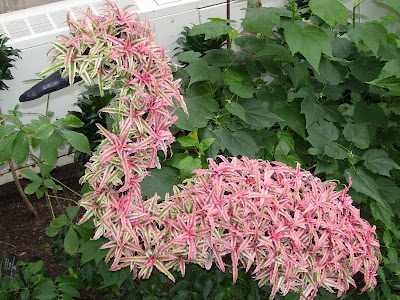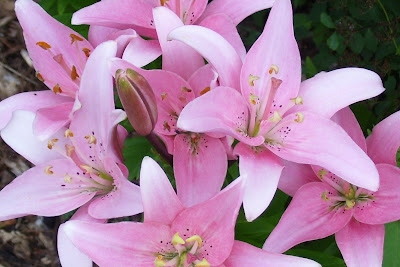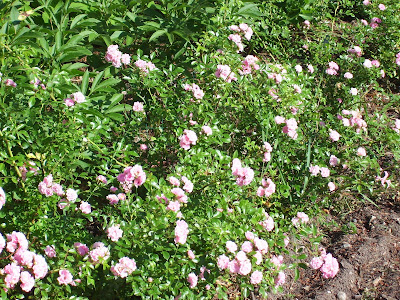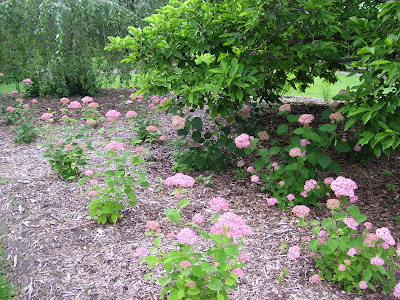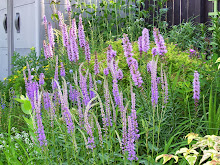 One-time potato farmer and his daughter (age 2), future potato picker. The baby there will be picking potatoes, too, in about six years.
One-time potato farmer and his daughter (age 2), future potato picker. The baby there will be picking potatoes, too, in about six years.I read
this article bemoaning BASF's withdrawal from Europe. It seems they have been busy doing GMO-research on the lowly spud. Europeans (population and their politicians and law makers) want nothing to do with this GMO-potato which BASF would like to see grown for "industrial purposes".
So where are they going? Oh yes, you've probably guessed it. They are moving their research to a country that is open to the use of GMO-crops and research on developing those crops. They are moving all their research to the USA.
I'm not a potato expert, not of the chemistry of them, not of the mapping of the potato genome, not of where what proteins and starches lie on the structure of the recombinant DNA.
I grow them. I eat them. That's about the extent of my knowledge. I have to admit, there is not a time I can remember that I haven't known how to chit potatoes, or knew how they grew in the ground, or what the taste of newly dug potatoes actually tasted like. It is like I was born knowing these things as my dad grew them as a cash crop before everything became so mechanized.
I can remember my dad digging them up using a one row potato digger that laid them out on the ground. Someone would ride the digger to make sure the weeds and the vines didn't snarl up the two-foot wide chain.
My dad would sell them to Frito-Lay for chipping potatoes. The local Frito-Lay manufacturer would chip up a hundred pound burlap bag and the aroma of fresh chips would waft out to the car where my sisters and I waited. If the company was happy and would buy 300 hundred pound bags, we would have our work cut out for us scooping up the potatoes into wire potato baskets after school for the next week. But before then, we would get to partake of the freshly chipped potatoes grown in our own soil.
I was probably about eight.
The local manufacturer is gone. My dad no longer grows ten to twenty acres of potatoes as a cash crop. My mother worked as a potato inspector for over a decade for the State of Wisconsin. I think she might know more about potatoes than my dad.
As an adult, it doesn't surprise me that potatoes are the world's fourth most important food crop behind rice, corn, and wheat. What did set me to thinking though is what were the industrial uses which are behind mapping a potato's genome and developing genetically modified potatoes?
The only answer I could come up with was starches.
Potatoes are all about starches. They are the the leading source of starch per acre world-wide, nearly one-third higher than corn. Bayer is one of the companies that are
all over this. Potatoes are a sustainable source of starch, they tout.
So you can probably figure out why BASF feels that if there is a significant amount of push-back from Europe, they'll just pick up and go elsewhere with their research and why some might be bemoaning this decision.
Doing a bit of research into what are considered "industrial uses" of these GMO-potatoes, I surprisingly also came up with the manufacture of seed potato as an industrial use, along with animal feed. This is where it starts to get really sticky for me. Potato starches from these GMO-potatoes could be used in compostable plates, carrier bags, biodegradable plant pots, cutlery, wall paper paste, adhesives, in addition to biosurfactants currently being made from petroleum that appear in soap, detergents, and shampoos. The uses appear nearly limitless.
Potatoes can replace oil.
And, it's hard for me to wrap my mind around the science of it.
It also turns out they have been tinkering around with the potato for awhile. In the 1990s, they released a potato resistant at a genetic level to Colorado potato beetle.
My son wants to major in chemistry at college this fall. Maybe, I'll wait for him to finish his degree and he can explain the sciencey part of whether this is good or bad for us. I have a feeling what some of the jobs for our brightest young people may be. It probably won't be potato inspector nor grower.


















